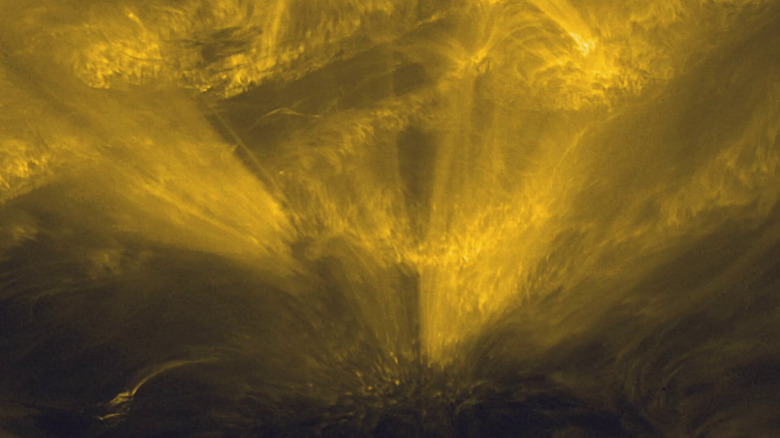How Solar Orbiter Is Capturing Images Of The Sun Close Up
It's not easy to study the sun in detail — it's so bright and hot that it's difficult to get anything up close enough for a good look. But the European Space Agency's Solar Orbiter will bring the closest camera to the sun to date and take detailed images of the celestial body, which will reveal more about the fascinating life of our star (via ESA). In March 2022, Solar Orbiter made its closest approach yet to the sun, called its perihelion. Since then, scientists have been furiously studying the data which the spacecraft captured, and in May 2022, they shared some preliminary looks at what this data could reveal.
When Solar Orbiter made its approach, it was within the orbit of Mercury and around one-third of the distance between Earth and the sun — and that was close enough that its heatshield reached a temperature of 932 degrees Fahrenheit (via ESA). But this close-up view allowed its 10 instruments to capture detailed information about the sun and reveal strange new phenomena.
The Extreme Ultraviolet Imager (EUI) instrument, for example, studies the part of the sun's atmosphere called the solar corona. It spotted a huge set of spikes reaching out from the sun, stretching a massive 15,534 miles across, which the researchers have nicknamed "the hedgehog." (via ESA). The spikes of hot and cooler gas reach temperatures of around 1.8 million degrees Fahrenheit. "The images are really breathtaking," said the lead investigator for EUI, David Berghmans of the Royal Observatory of Belgium. "Even if Solar Obiter stopped taking data tomorrow, I would be busy for years trying to figure all this stuff out."
Understanding space weather and more
Other findings about the sun will help progress our understanding of space weather. When radiation from the sun speeds out through the solar system due to an event like a solar flare, it can have wide-range effects called space weather. This space weather can affect satellites here on Earth and can be dangerous to astronauts, so understanding and predicting it is important for future space projects (via NASA). Solar Orbiter was able to detect several coronal mass ejections — when the sun throws off large amounts of plasma in a particular direction — and so the team was able to predict when these would hit Earth. Around 18 hours after the coronal mass ejections occurred, they struck Earth as predicted.
Another finding was related to the huge area of charged particles that form a bubble around the sun — including the planets in our solar system and beyond — called the heliosphere. Using Solar Orbiter's instruments, researchers were able to see where these particles were being produced. Now the researchers are focused on the next close pass to the sun that'll happen in October 2022, during which Solar Orbiter will get even closer. "We are so thrilled with the quality of the data from our first perihelion," said one of the Solar Orbiter project scientists, Daniel Müller of ESA. "It's almost hard to believe that this is just the start of the mission. We are going to be very busy indeed."
